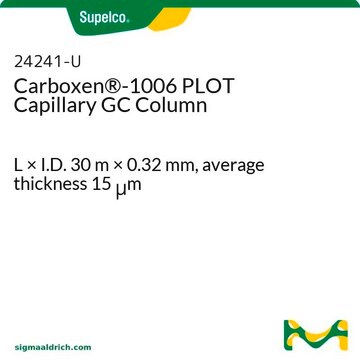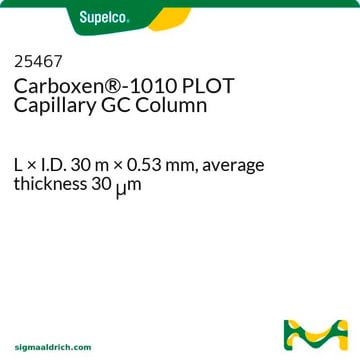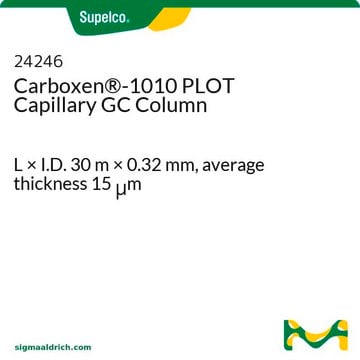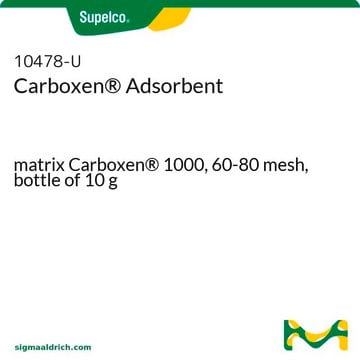If this product has an expiration or retest date, it will be shown on the Certificate of Analysis (COA, CofA). If there is no retest or expiration date listed on the product's COA, we do not have suitable stability data to determine a shelf life. For these products, the only date on the COA will be the release date; a retest, expiration, or use-by-date will not be displayed.
For all products, we recommend handling per defined conditions as printed in our product literature and website product descriptions. We recommend that products should be routinely inspected by customers to ensure they perform as expected.
For products without retest or expiration dates, our standard warranty of 1 year from the date of shipment is applicable.
For more information, please refer to the Product Dating Information document: https://www.sigmaaldrich.com/deepweb/assets/sigmaaldrich/marketing/global/documents/449/386/product-dating-information-mk.pdf
32221-M
Ethyl alcohol, pure
≥99.8% (GC), absolute, puriss. p.a.
Synonyme(s) :
Alcool éthylique
About This Item
Produits recommandés
Nom du produit
Éthanol, puriss. p.a., absolute, ≥99.8% (GC)
Densité de vapeur
1.59 (vs air)
Pression de vapeur
44.6 mmHg ( 20 °C)
Qualité
absolute
puriss. p.a.
Essai
≥99.8% (GC)
Forme
liquid
Température d'inflammation spontanée
683 °F
Limite d'explosivité
19 %, 60 °F
Technique(s)
GC/GC: suitable
Impuretés
furfural, in accordance
≤0.0001% free alkali (as NH3)
≤0.0001% heavy metals (as Pb)
≤0.0003% KMnO4 red. matter (as O)
≤0.0005% free acid (as CH3COOH)
≤0.001% acetone (GC)
≤0.001% aldehydes (as CH3CHO)
≤0.001% non-volatile matter
≤0.003% 2-propanol
≤0.003% carbonyl compounds (as CO)
≤0.02% methanol (GC)
≤0.05% iso-amyl alcohol
≤0.2% water (Karl Fischer)
Indice de réfraction
n20/D 1.3600 (lit.)
n20/D 1.3614-1.3618
pH
7 (20 °C, 10 g/L)
pb
78 °C (lit.)
Pf
−114 °C (lit.)
Traces de cations
Al: ≤0.5 ppm
B: ≤0.02 ppm
Ba: ≤0.1 ppm
Ca: ≤0.5 ppm
Cd: ≤0.05 ppm
Co: ≤0.02 ppm
Cr: ≤0.02 ppm
Cu: ≤0.02 ppm
Fe: ≤0.1 ppm
Mg: ≤0.1 ppm
Mn: ≤0.02 ppm
Ni: ≤0.02 ppm
Pb: ≤0.1 ppm
Sn: ≤0.1 ppm
Zn: ≤0.1 ppm
Chaîne SMILES
CCO
Adéquation
complies for UV absorption
complies for appearance
complies for identity A
complies for identity B
passes test for reaction against H2SO4
Format
neat
InChI
1S/C2H6O/c1-2-3/h3H,2H2,1H3
Clé InChI
LFQSCWFLJHTTHZ-UHFFFAOYSA-N
Vous recherchez des produits similaires ? Visite Guide de comparaison des produits
Application
Il peut être utilisé :
Note de bas de page
Mention d'avertissement
Danger
Mentions de danger
Conseils de prudence
Classification des risques
Eye Irrit. 2 - Flam. Liq. 2
Code de la classe de stockage
3 - Flammable liquids
Classe de danger pour l'eau (WGK)
WGK 1
Point d'éclair (°F)
55.4 °F - closed cup
Point d'éclair (°C)
13 °C - closed cup
Faites votre choix parmi les versions les plus récentes :
Déjà en possession de ce produit ?
Retrouvez la documentation relative aux produits que vous avez récemment achetés dans la Bibliothèque de documents.
-
How can I determine the shelf life / expiration / retest date of this product?
1 answer-
Helpful?
-
-
How is shipping temperature determined? And how is it related to the product storage temperature?
1 answer-
Products may be shipped at a different temperature than the recommended long-term storage temperature. If the product quality is sensitive to short-term exposure to conditions other than the recommended long-term storage, it will be shipped on wet or dry-ice. If the product quality is NOT affected by short-term exposure to conditions other than the recommended long-term storage, it will be shipped at ambient temperature. As shipping routes are configured for minimum transit times, shipping at ambient temperature helps control shipping costs for our customers. For more information, please refer to the Storage and Transport Conditions document: https://www.sigmaaldrich.com/deepweb/assets/sigmaaldrich/marketing/global/documents/316/622/storage-transport-conditions-mk.pdf
Helpful?
-
-
As this product is not denatured. Can we make it denatured by adding 1% Methanol in it. Request advice.
1 answer-
It is possible to denature Ethanol via the addition of Methanol. The final Methanol concentration is generally above 1%, frequently in the range of 5 to 10%.
Helpful?
-
-
Sehr geehrte Damen und Herren, ist der Ethanol 32221-M (puriss. p.a., absolute, ≥99.8% (GC)) vergällt / denaturiert oder unvergällt / nicht-denaturiert? Leider ist mir das weder von der Homepage noch vom SDB endgültig ersichtlich. Beste Grüße!
1 answer-
This product is not denatured.
Helpful?
-
-
Bonjour, Quelle est la différence entre la référence 32205-1L-M et la référence 32221-1L-M? Merci
1 answer-
These products are physically identical with the same minimum purity specification. Product 32205-M is reagent grade which is suitable for general lab applications. It meets some of the analytical specifications of European Pharmacopoeia and testing includes trace analysis. Product 32221-1L-M is Puriss p.a. grade meaning the testing is also extensive and includes trace analysis. The quality of these products is comparable.
Please see the links below to review the tests and specifications for each item.
33205 Specifications
https://www.sigmaaldrich.com/specification-sheet/SIGALD/3220532221 Specifications
https://www.sigmaaldrich.com/specification-sheet/SIGALD/32221Helpful?
-
Active Filters
Notre équipe de scientifiques dispose d'une expérience dans tous les secteurs de la recherche, notamment en sciences de la vie, science des matériaux, synthèse chimique, chromatographie, analyse et dans de nombreux autres domaines..
Contacter notre Service technique









